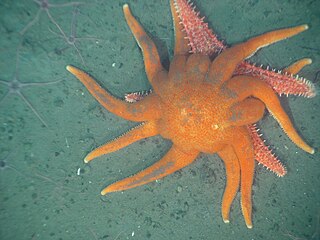
The Valvatida are an order of starfish in the class Asteroidea, which contains 695 species in 172 genera in 17 families.

Heteroconchia is a taxonomic infraclass of diverse bivalve molluscs, belonging to the subclass Autobranchia.
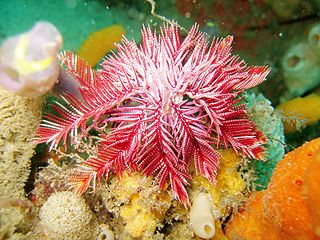
Articulata are a subclass or superorder within the class Crinoidea, including all living crinoid species. They are commonly known as sea lilies or feather stars. The Articulata are differentiated from the extinct subclasses by their lack of an anal plate in the adult stage and the presence of an entoneural system. Articulata first appeared in the fossil record during the Triassic period although other, now extinct crinoid groups, originated in the Ordovician.

Astropecten is a genus of sea stars of the family Astropectinidae.

Gorgonocephalus is a genus of marine basket stars in the class Ophiuroidea. Members of this genus are found in coldwater environments including the Arctic, the Antarctic, and deep-sea habitats. The scientific name comes from the Greek, gorgós meaning "dreaded" and -cephalus meaning "head", and refers to the similarity between these echinoids and the Gorgon's head from Greek myth with its coiled serpents for hair.

Cidaridae is a family of sea urchins in the order Cidaroida.

Echinidae is a family of sea urchins in the order Camarodonta. Members of the family are found in the Atlantic Ocean and the Antarctic.

Davidaster is a genus of crinoids. According to the World Register of Marine Species, a number of species that originally were included in the genus Nemaster are now included in Davidaster. Members of this genus have wedge-shaped arms, except for the basal ones, often longer than they are wide. The mouth is off centre and there are no pinnule combs after pinnule 3. The primary comb has the teeth widely separated and confluent with the lateral edge of the segment.

Comatulida is an order of crinoids. Members of this order are known as feather stars and mostly do not have a stalk as adults. The oral surface with the mouth is facing upwards and is surrounded by five, often divided rays with feathery pinnules. Comatulids live on the seabed and on reefs in tropical and temperate waters.
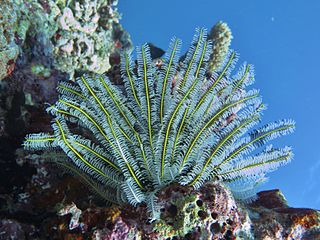
Comaster schlegelii, the variable bushy feather star, is a crinoid in the family Comatulidae. It was previously classified as Comanthina schlegeli but further research showed that it was better placed in the genus Comaster. It is found on shallow water reefs in the western Pacific Ocean.
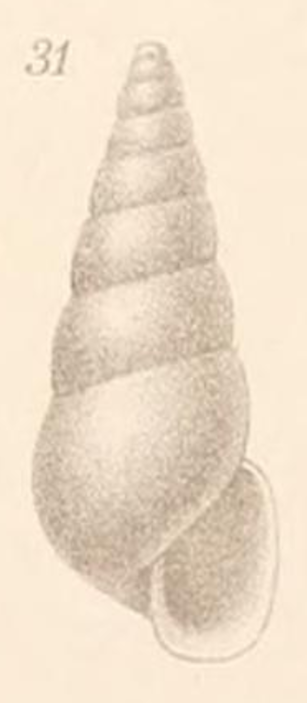
Bathycrinicola tumidula is a species of sea snail, a marine gastropod mollusc in the family Eulimidae.

Bourgueticrinida is an order of crinoids that typically live deep in the ocean. Members of this order are attached to the seabed by a slender stalk and are known as sea lilies. While other groups of crinoids flourished during the Permian, bourgueticrinids along with other extant orders did not appear until the Triassic, following a mass extinction event in which nearly all crinoids died out.

Comatulidae is a family of comatulid crinoids. Since 2015, it replaces the family Comasteridae.
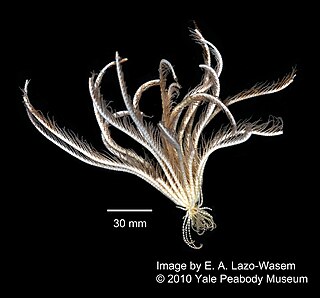
Promachocrinus kerguelensis is a species of free-swimming, stemless crinoids. It was the only member of its genus until several species were discovered in 2023. P. keruguelensis a coldwater crinoid which is found in the seas around Antarctica and surrounding island groups, including under the sea ice.
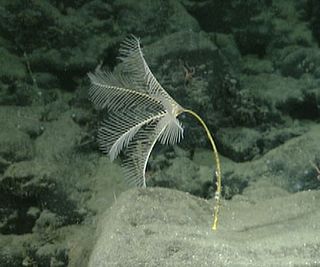
Hyocrinida is an order of sea lilies which contains a single extant family, Hyocrinidae.

Cyrtocrinida is an order of sea lilies which contains two suborders and three families.

Aporometridae is a monotypic family of crinoids, the only genus being Aporometra, which contains three species, all endemic to the seas around Australia.

Notocrinus virilis is a marine invertebrate, a species of crinoid or feather star in the family Notocrinidae. It is found in deep water in the Southern Ocean around the coasts of Antarctica and adjacent islands. A sea snail sometimes parasitizes it.
Brissopsis is a genus of echinoderms belonging to the family Brissidae.
Brisaster is a genus of echinoderms belonging to the family Schizasteridae.


















